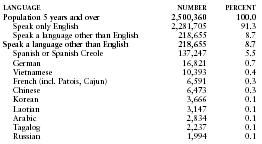Kansas
Languages
Plains Indians of the Macro-Siouan group originally populated what is now Kansas; their speech echoes in such place-names as Kansas, Wichita, Topeka, Chetopa, and Ogallah.
Regional features of Kansas speech are almost entirely those of the Northern and North Midland dialects, reflecting the migration into Kansas in the 1850s of settlers from the East. Kansans typically use fish(ing) worms as bait, play as children on a teetertotter, see a snakefeeder (dragonfly) over a /krik/ (creek), make white bread sandwiches, carry water in a pail, and may designate the time 2:45 as a quarter to, or of, or till three.
The migration by southerners in the mid-19th century is evidenced in southeastern Kansas by such South Midland terms as pullybone (wishbone) and light bread (white bread); the expression wait on (wait for) extends farther westward.
In 2000, 2,281,705 Kansans—91.3% of the residents five years old or older (down from 94.3% in 1990)—spoke only English at home.
The following table gives selected statistics from the 2000 census for language spoken at home by persons five years old and over.

| LANGUAGE | NUMBER | PERCENT |
| Population 5 years and over | 2,500,360 | 100.0 |
| Speak only English | 2,281,705 | 91.3 |
| Speak a language other than English | 218,655 | 8.7 |
| Speak a language other than English | 218,655 | 8.7 |
| Spanish or Spanish Creole | 137,247 | 5.5 |
| German | 16,821 | 0.7 |
| Vietnamese | 10,393 | 0.4 |
| French (incl. Patois, Cajun) | 6,591 | 0.3 |
| Chinese | 6,473 | 0.3 |
| Korean | 3,666 | 0.1 |
| Laotian | 3,147 | 0.1 |
| Arabic | 2,834 | 0.1 |
| Tagalog | 2,237 | 0.1 |
| Russian | 1,994 | 0.1 |